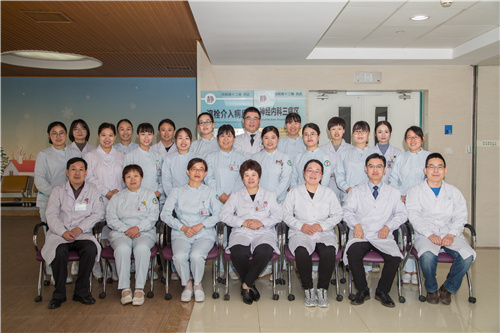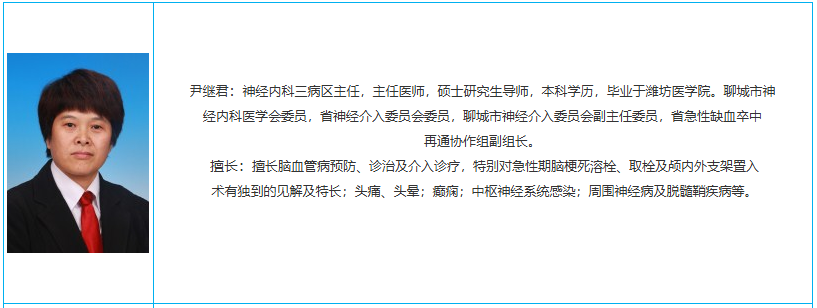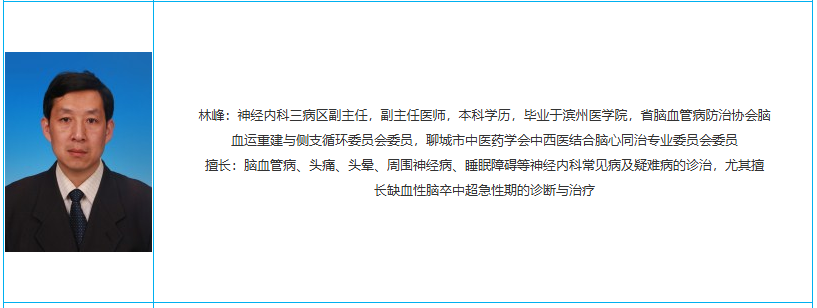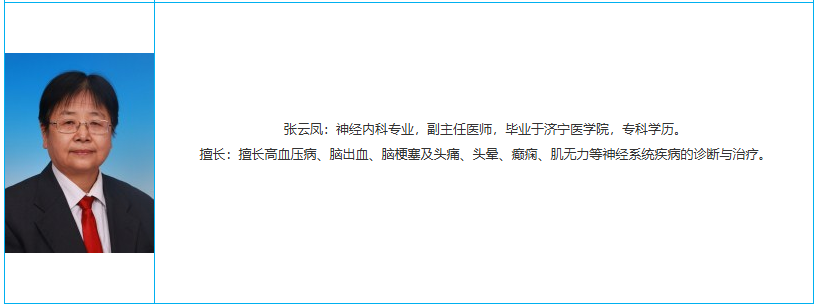- Date:2022-09-20
Neurology three wards have a total of 48 open beds, at present the department has a total of 10 physicians, 1 chief physician, 3 deputy chief physicians, 4 attending physicians, 2 residents, including 1 master's degree tutor, 6 master of medicine. In 2014, the hospital established a thrombolysis and intervention ward in Neurology Ward 3, which mainly undertakes the drug and intervention treatment of ischemic cerebrovascular disease, and is especially good at the techniques of intravenous thrombolysis and mechanical thrombolysis.
I. Specialising in the field of technology, innovation to a higher level
The main research direction of the department is neuro-interventional diagnosis and treatment of ischemic cerebrovascular disease, and it has sent people to Xuanwu Hospital of Capital Medical University, Tiantan Hospital, Jiangsu Provincial People's Hospital, Shaw Hospital of Zhejiang Province, and Qianfoshan Hospital of Shandong Province for further study, and currently carries out the following procedures, including cerebral arteriography, balloon dilatation of stenosis of intracranial and extracranial arteries and stenting, arterial recanalization of chronic occlusions, and mechanical thrombectomy for acute ischemic stroke. Mechanical Embolisation for Acute Ischaemic Stroke. Among them, mechanical thrombectomy has filled the gap in the neighbouring areas of Linqing City. Up to now (2020-12-31), the department has completed 950 cases of cerebral arteriography, 445 cases of interventional therapy, 132 cases of emergency mechanical thrombolysis, and 561 cases of intravenous thrombolysis for acute ischemic stroke. Since 2014, the department has consecutively led the development of ‘acute ischaemic stroke bridging treatment’, ‘acute ischaemic stroke early multi-technology joint vessel opening’, ‘cerebral artery chronic total occlusion lesion (’CTO‘) recanalisation’, and ‘cerebral arterial chronic total occlusion lesion (’CTO‘) recanalisation’ in the hospital. CTO recanalisation’, “PEARS technique for opening carotid tandem occlusion lesions”, “Application of balloon guided catheter (BGC) in opening intracranial large artery occlusion”, and other new technologies, and won the first prize, first prize, second prize, and second prize of the hospital's new technology respectively. technology first prize, first prize, second prize and second prize respectively, further improving the level of neurointervention in our hospital. The development of these technologies has greatly reduced the recurrence rate, death rate and disability rate of cerebrovascular disease, enabling many severely ill patients to recover physically and mentally, reducing the burden on families and society, and has been praised by patients and their families in the surrounding areas of the hospital.
Second, the first to strive for excellence, fruitful academic achievements
In addition to a large number of clinical work, the department has also made some academic achievements, and has gained the recognition of the leadership, colleagues and experts in the field, harvested a number of part-time and honours.
Genome-wide Profiling of miRNA and mRNA Expression in Alzheimer's Disease’, ’Botulinum toxin type A with or without needle Botulinum toxin type A with or without needle electromyographic guidance in patients with cervical dystonia’, ’Reflux compensation of persistent proatlantal intersegmental artery report of one case’ and many others, and again in 2021, ’Assessing the Efficacy and Safety of Tirofiban in Combination with Dual-Antiplatelet Therapy in Progressive Ischemic Stroke Patients’, “Identification of Potential Diagnostic miRNAs Biomarkers for Alzheimer Disease Based on Weighted Gene Coexpression Network Analysis”, ’Thrombolysis and embolectomy. Thrombolysis and embolectomy in treatment of acute stroke as bridge to open-heart resection giant cardiac myxoma: A case report’ was included in SCI, which is a strong proof of the clinical practice and the strength of translation into research and teaching. The strength of translating clinical practice into research and teaching has been recognised worldwide. In Chinese core journals, he has published many papers such as ‘Clinical efficacy and safety of tirofiban combined with dual antiplatelet therapy for progressive stroke’, ‘Correlation between serum endolipin and CRP levels and carotid atherosclerotic plaque stability in patients with cerebral infarction’, ‘Multi-technology combined treatment of acute internal carotid artery occlusion’, ‘Report on 1 case of bilateral internal carotid artery entrapment starting with fainting’ etc. He has been cited for many times.
2. Scientific research: presided over and participated in one provincial scientific research project, more than 10 municipal scientific research and completed scientific research appraisal, and successfully implemented and completed, and achieved good social benefits.
3. Part-time social work: Dr Yin Jijun, Chief Physician, Dr Lin Feng, Deputy Chief Physician, Dr Chang Wansheng, Deputy Chief Physician, and Dr Zhang Haiqi, Attending Physician, have undertaken part-time work for many societies in the province and completed the assigned work.
4. Academic exchanges: On behalf of the Department of Neurology, Dr Chang Wansheng has made academic speeches and case reports at national and provincial academic conferences for many times, which have been recognised by authoritative experts from higher hospitals. He participated in the ‘4C-Chinese Stroke Centre Alliance Basic Hospital Training Camp’ knowledge and case competition held by the China Stroke Association and the Office of Chinese Stroke Centre Alliance, and won the first place ‘Winner Award’. She was selected to study at the Hospital attached to the University of Traditional Chinese Medicine in Taiwan and Chun Hsin Hospital. He was awarded the title of ‘Excellent Young Job Holder’ and ‘Outstanding Worker’ in Linqing City, and the title of ‘Excellent Youth Worker’ in Liaocheng City. On behalf of our neurology department, attending physician Zhang Haiqi made an academic report at the Fifth Tiantan International Cerebrovascular Disease Conference in 2019, and his report won the excellent paper exchange award, which was highly praised by many experts.
Third, not forgetting the beginning, do a good job in teaching and helping
The staff of the department enthusiastically participated in and successfully completed the work of teaching interns, trainees, rotating physicians and primary general practitioners arranged by the hospital, and won the second prize of excellent instructor in the student skills competition. Successfully completing the work of counterpart support for county hospitals, they also regularly go to the surrounding county hospitals and township hospitals for lectures and exchanges of study, focusing on the knowledge of prevention and control of stroke, the development and application of new technologies such as intravenous thrombolysis and mechanical thrombolysis in ischaemic stroke, etc. Through the work mentioned above, they have helped the grass-roots medical personnel to abandon some old concepts and diagnosis and treatment techniques, and played a very good role in regulating and improving their diagnostic and treatment behaviours.
Based on the concept of ‘everything serves the patient, everything is beneficial to the patient’, the Neurology Ward 3 of Liaocheng Second People's Hospital uses the latest scientific research achievements and diagnosis and treatment technology to serve the surrounding masses!







 鲁ICP备11009722号-4
鲁ICP备11009722号-4 